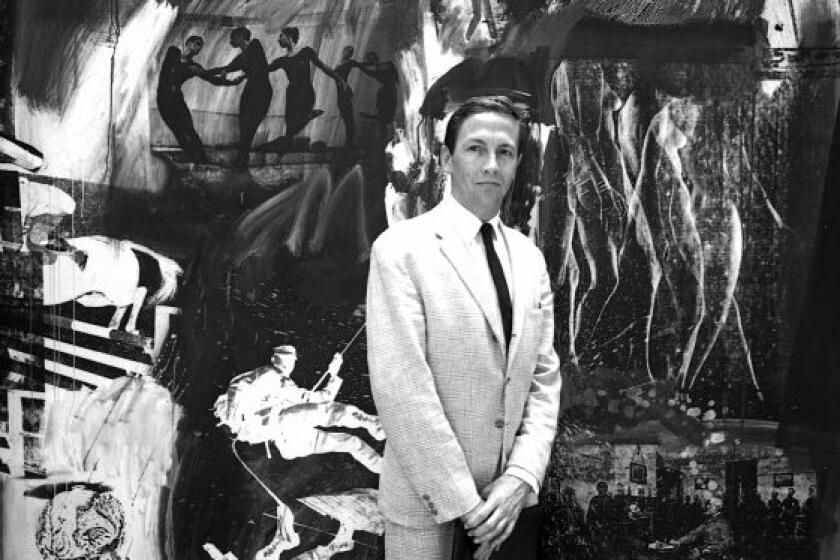Color Scheming
Color--and the unabashed expression thereof--is having a field day at the Orlando Gallery, where Diane J. Manchen and Zolita Sverdlove are showing their wares. This is not to say that the artists are on the same conceptual or thematic wavelength.
Diane J. Manchen stays indoors, figuratively speaking, lavishing intense hues and patterns on still-life works that aren’t very still. Zolita Sverdlove, meanwhile, takes her imagination and skills outdoors, into the territory of California landscapes that suggest farther-flung locales. They meet on the common ground of a vivid palette.
Color is obviously a fixation for Manchen, judging only from her show’s title, “Poly-Chromatic Universe.” Her paintings depict tightly cropped arrangements of tableware, yet veer away from traditional still-life values.
Instead of attending to the business of patiently dealing with volumes and forms, Manchen savors the illusory properties of reflective, distorting surfaces and compressed space.
She trains her eye on colored-glass vessels, the loopy reflections of spoons and the candy-colored swirls of marbles, all against dizzying backgrounds of floral print, parquet-patterned or aggressively striped tablecloths.
More is better here, as she organizes objects and settings for maximum density of visual activity. In an artist’s statement, she claims the influence of Matisse and the Fauves, but seems to owe more to post-pop painters like Wayne Thiebaud, who made desserts look delectable and artful, and to touches of super-realist tactics. The secret to her escapist aesthetic may be contained in the title to a typically busy composition, “Opposites Attract.”
Drawing on a subtle and rough-hewn painterly gift, Sverdlove shows landscape paintings of the great outdoors in our veritable backyard, although we may not immediately recognize the scenes. Her landscapes are just impressionistic enough to throw off the scent of familiarity, and she displays a romantic’s sense of transference, finding allusions to other places. Thus, she views “New Mexico Clouds Over L.A.” and an uncharacteristic purple haze in “Winter Skies Over Santa Barbara.”
Color plays a central role in her vision, as with the outburst of yellows and oranges in “Sea of Flowers,” consuming the lower half of the canvas. This subject could have been gaudy in the wrong hands, but Sverdlove’s grace and balance save the day. These are paintings about nature as well as about the pure inner life of painting.
*
Biblical Knowledge: “Works from the Bible,” renowned sculptor George Segal’s impressive show of sculptural tableaux, is a nearly perfect house-warming gift to the still-new Skirball Cultural Center. The Skirball, occupying a hillside site just this side of the future Getty compound, is a massive edifice devoted to Jewish culture and heritage.
Whereas the rest of the museum tells the historical and cultural tale of Jewish life, Segal’s component offers a rare treatment of religious themes--approached head-on, without sublimation or ironic asides--in the normally secular realm of a museum space. It’s almost a disorienting experience encountering Segal’s room full of Bible stories in three-dimensions, created between 1958 and 1987.
Ironically, while Segal’s signature figurative sculpture chronicles dehumanized man, as faceless creatures caught in frozen time, these biblical works bring a more realistic and empathetic presence to stories from the Bible. They put faces and bodies on abstractions.
Most dramatically, Segal portrays “The Expulsion” with the newly ashamed Adam and Eve, heads downcast and with fig leaves covering privates. They are fleeing a painted wall of flame and are flanked by a lifeless, truncated Tree of Life. In “Jacob’s Dream,” two figures, one asleep and one ascending a ladder, stand against a nocturnal sky.
Abraham and Isaac are seen as a life-size father and son seized by a fateful moment, with father readying a sword against his offspring, awaiting God’s word. Segal subtitles the work, “In Memory of May 4, 1970: Kent State.”
The oldest piece here, “Legend of Lot,” from 1958, is also the one most typical of Segal’s trademark style. Lot, the old man of biblical lore who was lured into sleeping with his two daughters so that they might bear children, appears as a crude, slumping figure who looks as if he just crawled out of a vat of wet plaster, with fuzzy suggestions of his daughters in a painting behind. It’s a fittingly crude treatment of a tale about incest, which doubles as a meditation on morality.
The openly narrative spin of Segal’s biblical works, rendered with conscientious fidelity to the source, has a ring of relevance now that storytelling has been allowed back into the temple of art.
BE THERE
“Poly-Chromatic Universe,” by Diane J. Manchen, and “California Landscapes,” by Zolita Sverdlove, through April 27 at the Orlando Gallery, 14553 Ventura Blvd., Sherman Oaks. Gallery hours: Tue.-Fri., 10 a.m.-4 p.m.; (818) 789-6012.
“Works from the Bible,” by George Segal, through July 25 at the Skirball Cultural Center and Museum, 2701 N. Sepulveda Blvd., Los Angeles. Gallery hours: Tue.-Fri., 10 a.m.-4 p.m.; Sat., noon-5 p.m.; Sun. and holidays, 10 a.m.-5 p.m.; (310) 440-4500.
More to Read
The biggest entertainment stories
Get our big stories about Hollywood, film, television, music, arts, culture and more right in your inbox as soon as they publish.
You may occasionally receive promotional content from the Los Angeles Times.






